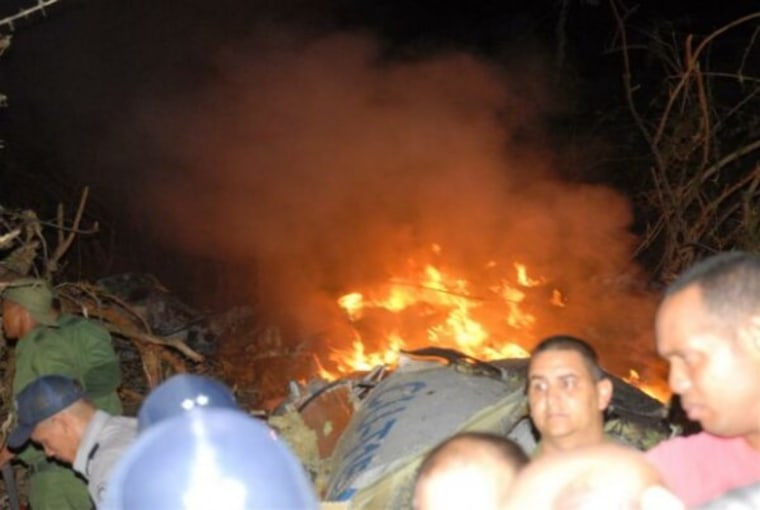Rescue workers on Friday pulled bodies from the charred wreckage of a state airliner that went down in rugged central Cuba, as desperate relatives gathered at the capital's airport and called foreign embassies seeking information on their loved ones.
All 68 people aboard AeroCaribbean Flight 883 were killed when the turboprop plane went down Thursday afternoon in a remote area near the village of Guasimal in Sancti Spiritus province.
Twenty-eight foreigners were among the dead, including nine Argentines, seven Mexicans, and citizens of Germany, Holland, Spain, Italy and other European countries. One Japanese national was also on board. It was Cuba's worst air disaster in more than 20 years.
State media reported that rescuers had found the plane's flight data recorders, a key step in possibly determining the cause of the crash.
AeroCaribbean Flight 883 was en route from the eastern city of Santiago de Cuba to the capital when it reported an emergency at 5:42 p.m. local time Thursday, then lost contact with air traffic controllers.
The pilot radioed that the plane was having problems before it plummeted to the ground, said NBC News, monitoring Cuban media reports. It went down near the village of Guasimal in Santi Spiritus province, carrying 61 passengers and a crew of seven.
One witness described the wreckage to Reuters as "a ball of flame in the middle of the mountain."
Cuba's Civil Aviation Authority issued a statement hours later saying there were no survivors. It released a list of passengers that included nine Argentines, seven Mexicans, three Dutch citizens, two Germans, two Austrians, a French citizen, an Italian, a Spaniard, a Venezuelan and a Japanese. The seven member crew were all Cuban, as were 33 passengers.
Photos posted on the website of the local newspaper, Escambray, showed a large piece of the plane in flames, with rescue workers in olive-green military uniforms standing around it. Others showed rescue workers using a bulldozer to reach the remote site.
Another picture showed an image of the AeroCaribbean plane in happier times, painted white, yellow and blue, and adorned with images of bending palm trees. The paper said the local Communist Party chief as well as Interior Ministry and other officials were at the scene helping with the effort.
Rescuers used bulldozers to clear a path to the scene, NBC News reported. Local press sources told the network that authorities had begun to remove bodies from the wreckage. Authorities cordoned off the crash site and did not allow reporters to approach. A refrigerated truck and another carrying body bags were seen entering the area, witnesses said.
Searchers have recovered the plane's two black boxes intact, police sources at the site told NBC News.
Medical facilities in the area, about 210 miles southeast of Havana, were put on alert to prepare for emergency patients. But by midnight they were told to stand down because no survivors were expected.
"There's nothing more here. They've deactivated the clinic already ... because, in reality, there are no survivors," an employee at Camilo Cienfuegos Hospital in Guasimal told Reuters.
The twice-a-week flight goes from Port-au-Prince, Haiti, to Santiago de Cuba to Havana. State media said that the plane was an ATR-72 twin turboprop and that the crash site was not far from the Zaza reservoir, the largest in Cuba. It said authorities had mobilized doctors and emergency workers in the rural area, which is about 220 miles east of Havana.
"At this time, the reasons of the accident are still unknown," The plane's manufactureer, ATR, said in a statement. It noted that the company was cooperating with Cuban aviation authorities in the investigation.
Aero Caribbean had operated the plane since October 2006. It was delivered from the production line in 1995 and had accumulated almost 25,000 flight hours in more than 34,500 flights, ATR said.
Information hard to come byAt Havana's national terminal, relatives of those on board the plane were kept isolated from other passengers and journalists.
"This is very sad," Caridad de las Mercedes Gonzalez, who was manning an airport information desk, said before officials announced that everyone had been killed. "We are very worried. This has taken us by surprise."
Cuban media was quick to release the passenger manifest, but details on the crash itself were hard to come by in a country whose press is tightly controlled.
A state television newscast hours after the crash led with news of an American ballet company's visit to Cuba, then reported on a Transportation Ministry decree that said travelers would be reimbursed or rescheduled if their trips were interrupted by tropical weather in eastern Cuba.
The announcers made no mention of the crash until they read a short statement toward the end of the broadcast. Subsequent newscasts just after midnight and in the early morning gave no details other than to repeat the same statement.
State media gave no details on what happened to the airliner, saying only that the cause of the crash was being investigated.
Deadliest crash in two decades
The flight would have been one of the last leaving Santiago de Cuba for Havana ahead of Tropical Storm Tomas, which was on a track to pass between Cuba's eastern end and the western coast of Haiti on Friday. Cuban media said earlier that flights and train service to Santiago were being suspended until the storm passed.
AeroCaribbean is owned by Cuban state airline Cubana de Aviacion.
The crash was the deadliest in Cuba since a chartered Cubana de Aviacion plane en route from Havana to Milan, Italy, went down shortly after takeoff in September 1989, killing all 126 people on board, as well as 24 people on the ground.
The last sizable passenger plane crash on the island occurred in March 2002, when a Soviet-made biplane carrying 16 people — including 12 foreigners — plunged into a small reservoir in central Cuba. The plane was operated by a small local charter company called Aerotaxi.
